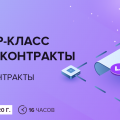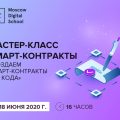The number of issued cryptocurrencies and digital tokens exceeded 7 thousand. In the ocean of cryptocurrency projectsinvestors find it difficult to recognize promisingservices at an early stage of development, and it is investments at this stage that allow you to get the maximum profit. UMI is one of the young projects created at the junction of decentralized finance and digital assets, which attracts attention not only with its unique functionality, but also with its declared development plans.
UMI is a universal monetary instrument withwith which users can make instant, secure and free financial transfers, as well as multiply cryptocurrency through profitable staking. In addition, UMI is a full-fledged blockchain platform capable of executing smart contracts of any complexity. Let's take a closer look at UMI capabilities.
Translations
The UMI network has a bandwidth of the order of4500 transactions per second. This significantly exceeds the similar indicators of most other blockchain networks, including such popular ones as Bitcoin or Ethereum.
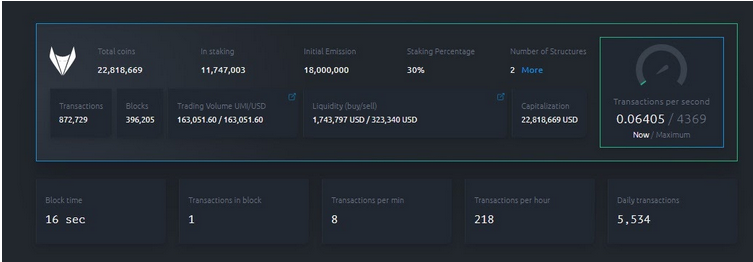
Mainnet UMI was launched in summer 2020, andthe process of its improvement continues. In the future, the UMI team will roll out an update that will increase the already high throughput to 10,000 transactions per second. This brings the UMI protocol closer to the transactional conductance of payment systems such as VISA and MasterCard. The UMI developers also have a long-term goal - to achieve a speed of 1 million transactions per second. Although at first glance this goal sounds too ambitious, there is a chance to achieve such bandwidth. First, the UMI network operates on an improved version of the Proof-of-Authority consensus (more on the details of the PoA consensus in UMI is discussed later). Second, such scaling can be achieved through the optimization of programming languages and smart contracts of the blockchain system, as well as the use of tools such as Kubernetes. Finally, due to its novelty and manufacturability, UMI network upgrades can be carried out faster and with less effort in terms of changing the internal architecture of the ecosystem.
Interest is also aroused by another plannedthe implementation of the payment service functionality of the UMI ecosystem is offline transactions. Other blockchain systems focus on transactions exclusively via the Internet, while in the UMI ecosystem, the procedure for sending transactions can be carried out without access to the World Wide Web using ordinary SMS or other communication methods. For example, the length of a UMI transaction is 150 bytes. That's 1200 bits of information. The standard length of an SMS is 1120 bits (140 bytes), that is, to send a transfer through the UMI blockchain, 2 SMS are needed. This is convenient if the translation needs to be sent urgently, but there is no Internet access. Technically, the UMI ecosystem is already ready to create offline transactions without an Internet connection, but a convenient service for sending such transfers has not yet been launched. The UMI team is developing it.
But the main difference between transactions in the UMI blockchainlies not so much in network bandwidth as in the absence of any fees for transfers. This was achieved by building an ecosystem on a unique technology, as well as using an economic model that is different from other popular cryptocurrencies.
Technology
The UMI blockchain is based on Proof-of-Authority technology, a concept proposed by Ethereum co-founder Gavin Wood.
Difference of PoA from popular algorithmsProof-of-Work (Bitcoin runs on it) or Proof-of-Stake (Ethereum plans to switch to PoS) is that there is no competitive race of miners or forgers in the PoA network for the right to create a block first and receive a reward. The formation of blocks, and most importantly, their sending to the blockchain, is handled by trusted nodes - master nodes. In the UMI network, master nodes are authorized large nodes that meet strict requirements for speed. This can significantly increase the network bandwidth.
But the original concept of PoA has its ownlimitations. The original PoA model assumes that ordinary users cannot influence the operation of the system, and only trusted nodes, which usually belong to one organization or affiliated companies, have the right to confirm transactions and record them in the blockchain. This increases the risks of network centralization, which deprives the cryptocurrency of its main value - decentralization - and makes it little different from other already existing traditional payment systems. In order to avoid the risk of network centralization, the nodes in the UMI blockchain are divided into two types - master nodes that write blocks to the blockchain, and validator nodes that confirm the correctness of the blocks. If only certain nodes can become master nodes - now they include nodes launched both by the UMI team and their numerous partners from different countries, then any user can launch a validator node. Validator nodes monitor the work of the master nodes, and in case of dubious actions, the unscrupulous master nodes are automatically disconnected from the system.
Apart from sharing power between master nodes andvalidator nodes, another mechanism will work in the UMI system in the future, including one that is also designed to prevent centralization - integration with the Proof-of-Stake consensus. The UMI blockchain will continue to operate on PoA consensus, but in case of problems with the master nodes, the system will automatically switch to the PoS fallback consensus. Even if all of the master nodes suddenly cease to function, the performance of the UMI network and its ability to conduct transactions will not be affected. PoS nodes do not need computing equipment to work, a regular laptop is enough. Any UMI users who have installed a desktop wallet with a validator node will be able to launch a backup PoS node.
Moreover, in the UMI system, staking works onsmart contract, which means that the staker does not need to keep the computer always on. Thanks to staking on a smart contract, you can generate new UMI coins up to 40% per month around the clock. With such a profitable economic model, UMI encourages users to actively connect to the system. The use of this model is one of the features thanks to which the UMI system was able to refuse to collect fees for transfers: staking participants are interested in the development of the ecosystem without additional remuneration in the form of commissions.
Smart contracts
The UMI blockchain allows you to create manyspecialized multifunctional smart contracts, including those suitable for integration into e-commerce services or for launching decentralized autonomous organizations (DAO). These include various decentralized finance (DeFi) services.
Areas of application of smart contracts based on the UMI blockchain:
- decentralized exchanges and applications,
- DeFi protocols, including for Yield Farming and lending,
- online stores,
- crowdfunding platforms,
- gambling sites,
- gaming platforms,
- cashback and points programs,
- and many other services.
Due to the high bandwidth UMI networkwill ensure the smooth operation of large DeFi projects, decentralized exchanges (DEX) or decentralized applications (DApps), and users will not face unprecedented high transaction fees, as happened on the Ethereum network. Thus, the launch of UMI-based DeFi services will not have a negative impact on those who use the system exclusively for money transfers.
Staking in detail
Now you can mine UMI coins in twostaking structures (pools) - ROY Club and ISP Club. To do this, you need to create a personal wallet in the UMI blockchain, transfer a certain number of UMI coins to your address.
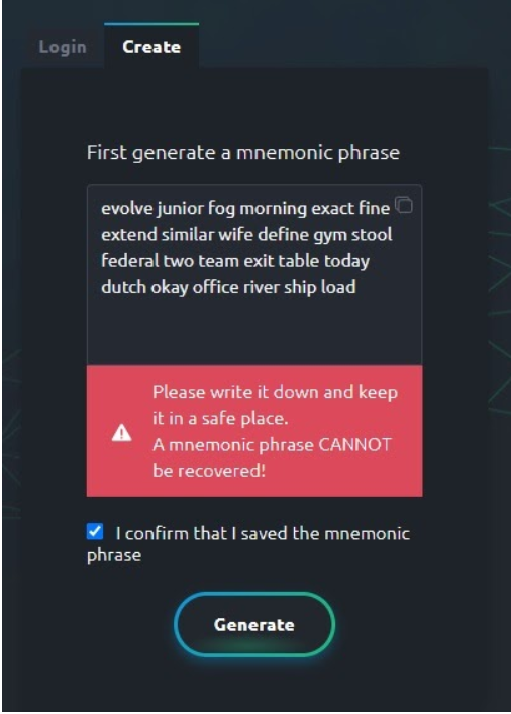
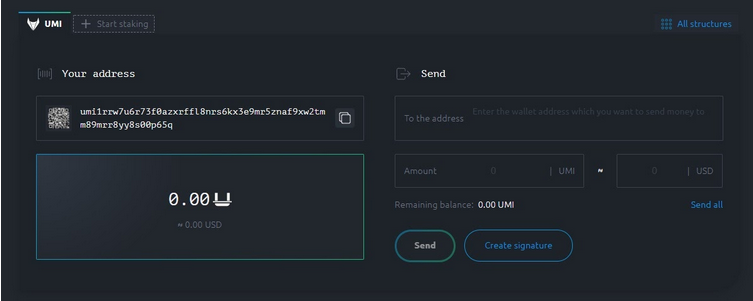
After replenishing the wallet address, you can placeyour coins for staking in two pools. Unlike other staking systems, coins in the UMI system are not frozen after joining a pool. They remain in the user's wallet and no one has access to them except the owner. Staking rewards are accrued 24/7. The user can withdraw them and sell them at any time.
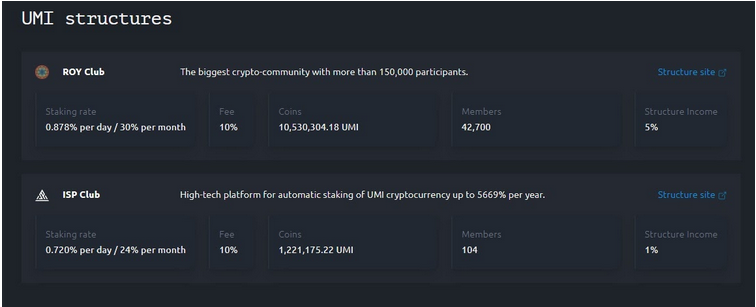
You can buy UMI coins on the trading platformSIGEN.pro, which unites an exchange, an automatic exchanger and a p2p platform. According to statistics, the daily trading volume of UMI is from $ 100,000 to $ 200,000, and the liquidity of the order book for buying coins, taking into account the p2p platform, has already exceeded $ 1.2 million. For a project launched only four months ago, the indicator looks very promising. The market's interest in UMI is indirectly evidenced by the rapidly growing number of active users: their number exceeded 41,000.
</p>BitNovosti.com publishes this sponsorship material “as is”. The information provided cannot be considered as investment advice by the editorial board. The reader must conduct an independent analysis of the information, and makes a decision at his own risk.

